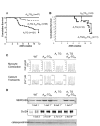Cardiac-restricted overexpression of the A(2A)-adenosine receptor in FVB mice transiently increases contractile performance and rescues the heart failure phenotype in mice overexpressing the A(1)-adenosine receptor
- PMID: 20354569
- PMCID: PMC2846643
- DOI: 10.1111/j.1752-8062.2008.00027.x
Cardiac-restricted overexpression of the A(2A)-adenosine receptor in FVB mice transiently increases contractile performance and rescues the heart failure phenotype in mice overexpressing the A(1)-adenosine receptor
Abstract
In the heart, adenosine binds to pharmacologically distinct G-protein-coupled receptors (A(1)-R, A(2A)-R, and A(3)-R). While the role of A(1)- and A(3)-Rs in the heart has been clarified, the effect of genetically manipulating the A(2A)-R has not been defined. Thus, we created mice overexpressing a cardiac-restricted A(2A)-R transgene. Mice with both low (Lo) and high (Hi) levels of A(2A)-R overexpression demonstrated an increase in cardiac contractility at 12 weeks. These changes were associated with a significantly higher systolic but not diastolic [Ca(2+)]i, higher maximal contraction amplitudes, and a significantly enhanced sarcoplasmic reticulum Ca(2+) uptake activity. At 20 weeks, the effects of A(2A)-R overexpression on cardiac contractility diminished. The positive effects elicited by A(2A)-R overexpression differ from the heart failure phenotype we observed with A(1)-R overexpression. Interestingly, coexpression of A(2A)-R TG(Hi), but not A(2A)-R TGLo, enhanced survival, prevented the development of left ventricular dysfunction and heart failure, and improved Ca(2+) handling in mice overexpressing the A(1)-R. These results suggest that adenosine-mediated signaling in the heart requires a balance between A(1)- and A(2A)-Rs--a finding that may have important implications for the ongoing clinical evaluation of adenosine receptor subtype-specific agonists and antagonists for the treatment of cardiovascular diseases.
Keywords: Ca2+ transients; adenosine receptors; cardiac myocytes; heart failure; transgenic mice.
Figures






References
-
- Yang D, Zhang Y, Nguyen HG, Koupenova M, Chauhan AK, Makitalo M, Jones MR, St Hilaire C, Seldin DC, Toselli P, Lamperti E, Schreiber BM, Gavras H, Wagner DD, Ravid K. The A2B adenosine receptor protects against inflammation and excessive vascular adhesion. J Clin Invest. 2006; 116(7): 1913–1923. - PMC - PubMed
-
- Klinger M, Freissmuth M, Nanoff C. Adenosine rec eptors: G protein‐mediated signalling and the role of accessory proteins. Cell Signal. 2002; 14(2): 99–108. - PubMed
-
- Norton GR, Woodiwiss AJ, McGinn RJ, Lorbar M, Chung ES, Honeyman TW, Fenton RA, Dobson JG Jr, Meyer TE. Adenosine A1 receptor‐mediated antiadrenergic effects are modulated by A2a receptor activation in rat heart. Am J Physiol. 1999; 276(2 Pt 2): H341–H349. - PubMed
-
- Yang Z, Cerniway RJ, Byford AM, Berr SS, French BA, Matherne GP. Cardiac overexpression of A1‐adenosine receptor protects intact mice against myocardial infarction. Am J Physiol Heart Circ Physiol. 2002; 282(3): H949–H955. - PubMed
Publication types
MeSH terms
Substances
Grants and funding
LinkOut - more resources
Full Text Sources
Medical
Miscellaneous

